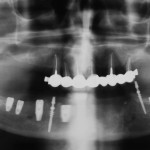
A certain amount of bone is required for the placement of dental implants and a range of techniques applied to reconstruct alveolar bone in order to place dental implants. The aim of this review was to assess the success rate of implants placed in horizontal and vertical guided bone regenerated (GBR) areas.
What did they do
The Medline, Embase, and Cochrane Library databases were searched together with the reference lists of identified papers. Studies in humans involving > 5 patients analysing the success rate of endosseus implants placed in jaws augmented by means of horizontal and vertical GBR with greater than 6 months follow-up were included. For studies reporting multiple time points the more recent data was used. Study quality was assessed. The main outcome was implant success.
What did they find
- Eight studies were included (1 randomised controlled trial, 1 controlled trial, 5 case series, 1 retrospective study).
- Four studies involved fewer than 17 patients. The other studies included 40, 49, 82 and 3192 patients.
- The estimated risk of bias is considered to be high for four studies, moderate for three and low for one.
- The length of follow up ranged from 1-11 years.
- The success rate of implants placed in GBR augmented ridges ranged from 61.5% to 100%;
- All studies, apart from three, reported a success rate higher than 90% (range 90–100%).
They concluded
The data obtained demonstrated that GBR is a predictable technique that allows the placement of implants in atrophic areas. Despite that, studies with well-defined implant success criteria after a longer follow-up are required.
Clementini M, et al. Success rate of dental implants inserted in horizontal and vertical guided bone regenerated areas: a systematic review, Int J Oral Maxillofac Surg (2012), doi:10.1016/j.ijom.2012.03.016
Comment
While the evidence presented in this review is of relatively low quality, with only one randomised controlled trial and the majority of the other studies being case-series the authors conclusions seem to be overly positive. It is also worth noting that a Cochrane review ( Esposito et al 2010) looked at the most effective technique for horizontal and vertical bone augmentation. That review identified 13 randomised controlled trials and concluded
These conclusions are based on few trials including few patients, sometimes having short follow-up, and often being judged to be at high risk of bias. Various techniques can augment bone horizontally and vertically, but it is unclear which are the most efficient. Short implants appear to be a better alternative to vertical bone grafting of resorbed mandibles. Complications, especially for vertical augmentation, are common. Some bone substitutes could be a preferable alternative to autogenous bone. Osteodistraction osteogenesis allows for more vertical bone augmentation than other techniques which on the other hand can allow for horizontal augmentation at the same time. Titanium screws may be preferable to resorbable screws to fixate onlay bone grafts.
Esposito M, Grusovin MG, Felice P, Karatzopoulos G, Worthington HV, Coulthard P. Interventions for replacing missing teeth: horizontal and vertical bone augmentation techniques for dental implant treatment. Cochrane Database of Systematic Reviews 2009, Issue 4. Art. No.: CD003607. DOI: 10.1002/14651858.CD003607.pub4.

This study simply noted the success rate of implants placed in GBR, and having this information, widens our knowledge towards the effectivess of such surgical method. As always, thank you for sharing your thoughts about this study.